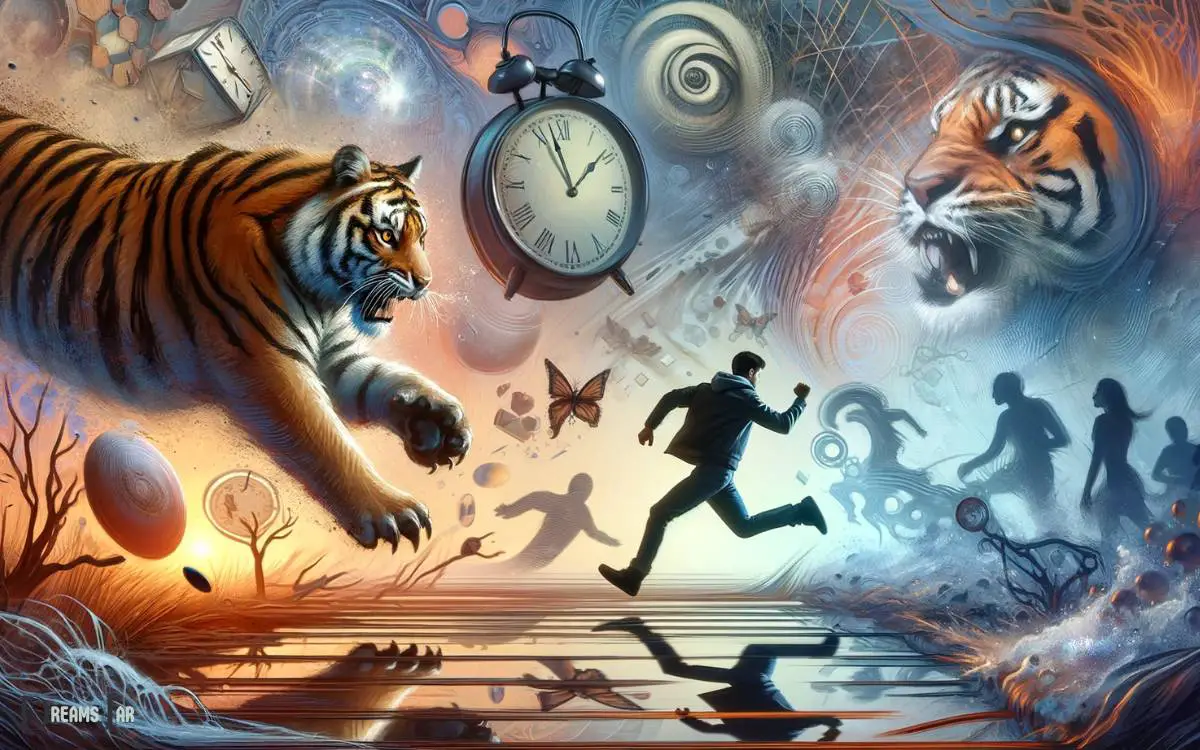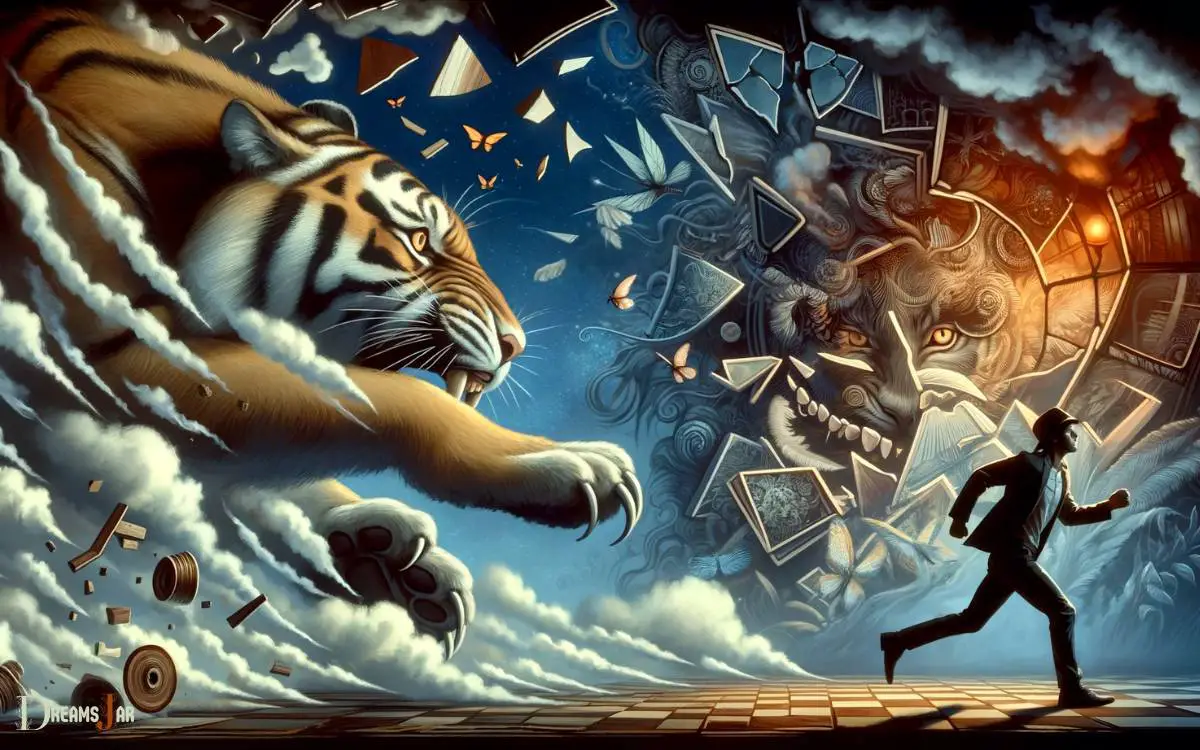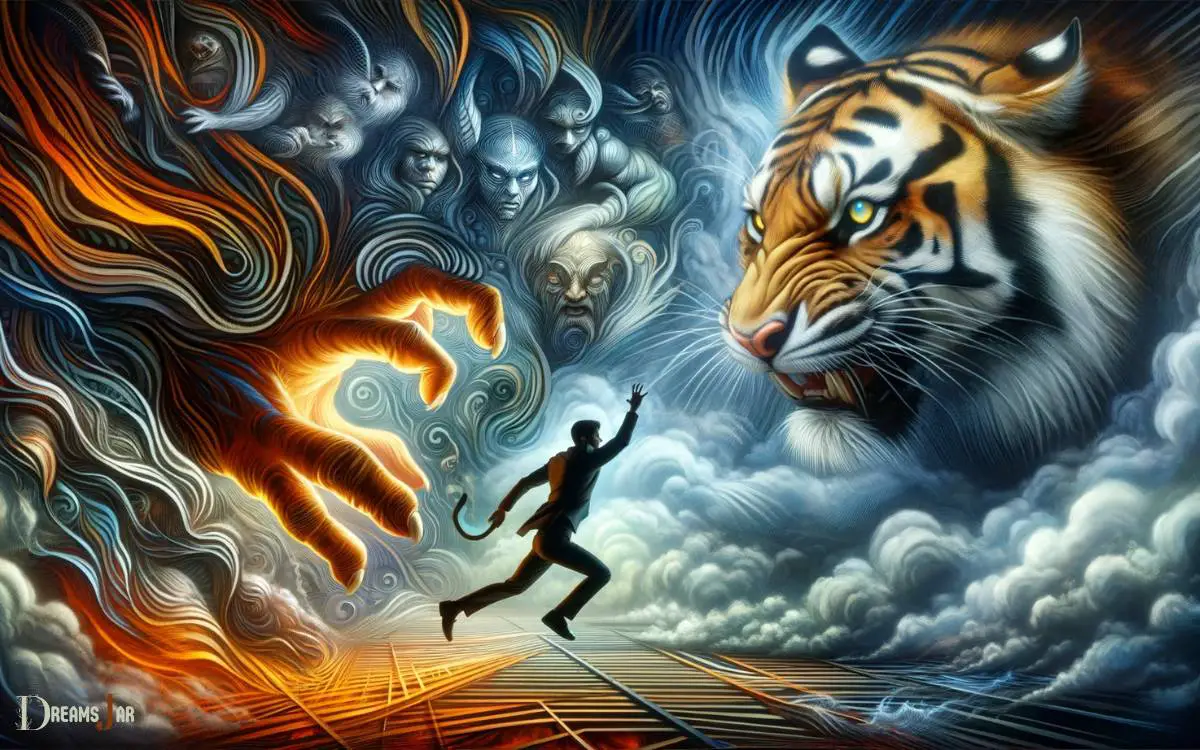Tiger Chasing Me in Dream Meaning: Threatened!
Dreams of a tiger chasing you may suggest feeling threatened or pursued by a powerful force in your waking life, reflecting a need to confront and overcome challenges or fears.
The symbolic meaning of a tiger pursuing them in a dream may reveal unresolved fears, power dynamics, and instincts at play in their waking life.
For example:
By delving into the psychological interpretation of this dream, individuals can explore the deeper layers of their emotions and experiences.

Key Takeaway
Psychological Interpretation

The psychological interpretation of dreaming about a tiger chasing someone can reveal underlying fears and anxieties.
- The tiger, as a symbol, often represents raw emotions, primal instincts, and untamed power.
- In this context, the act of being chased by a tiger in a dream may reflect the individual’s sense of being overwhelmed by these intense emotions or feeling threatened by something powerful in their waking life.
- It might indicate a struggle with personal fears, such as failure, loss, or rejection.
- Additionally, the chase could signify the avoidance of confronting these fears, leading to a sense of being pursued or trapped.
Understanding the psychological implications of such dreams can offer insights into the dreamer’s emotional state and provide an opportunity for introspection and growth.
Symbolism of Fear

Fear in dreams often serves as a warning sign, alerting the dreamer to potential dangers or anxieties in their waking life.
Understanding the symbolism of fear involves analyzing the subconscious fears that may be influencing one’s thoughts and actions.
Fear as Warning Sign
Experiencing fear in dreams can serve as a warning sign, symbolizing underlying anxieties or concerns that need attention.
In the realm of dream interpretation, fear can manifest as a symbolic representation of various aspects of one’s waking life.
It often carries significant meaning and can provide valuable insights into the dreamer’s emotions and subconscious mind.
Here are four key interpretations of fear as a warning sign in dreams:
- Unresolved Issues: Fear in dreams may indicate unresolved issues or emotions that are being ignored or suppressed.
- Impending Danger: It can symbolize a sense of impending danger or a need to be cautious in waking life.
- Internal Conflict: Fear may represent internal conflicts or struggles that require resolution and introspection.
- Neglected Emotions: It can serve as a reminder to address neglected emotions or aspects of one’s life that are causing distress.
Analyzing Subconscious Fears
Analyzing subconscious fears can provide valuable insights into one’s emotions and thought processes, shedding light on underlying anxieties and concerns that may require attention.
- Fear, in the realm of dreams and subconscious symbolism, often represents unresolved issues or worries.
- It acts as a messenger, urging the dreamer to confront hidden fears and anxieties that may be influencing waking life.
- Understanding the symbolism of fear can unlock profound revelations about one’s innermost fears and insecurities, offering an opportunity for growth and self-awareness.
- By delving into the subconscious mind’s portrayal of fear, individuals can gain a deeper understanding of their emotional landscape and the underlying factors contributing to their concerns.
This introspective journey allows for the exploration and potential resolution of deeply rooted fears, leading to a more balanced and harmonious inner state.
Overcoming Fear Symbolism
One significant aspect of overcoming fear symbolism is recognizing its pervasive influence on subconscious thoughts and behaviors.
Fear can manifest itself in various symbolic ways, and understanding these symbols can help individuals overcome their fears and anxieties.
Here are four key aspects of the symbolism of fear:
- Animal Symbolism: Animals often symbolize different fears and instincts, such as the fear of the unknown or the fear of being trapped.
- Recurring Themes: Identifying recurring themes in dreams or thoughts can provide insight into the underlying fears that need to be addressed.
- Physical Sensations: Symbolism of fear can also manifest through physical sensations, such as feeling paralyzed or unable to move in a dream.
- Confrontation and Resolution: Overcoming fear symbolism often involves confronting the fear symbol head-on and finding a resolution or a way to tame it.
Unresolved Conflict

The tiger in the dream represents a looming conflict that the dreamer has been avoiding. It symbolizes an unresolved issue that continues to chase them, causing fear and anxiety.
This dream may be a sign that it’s time for the dreamer to face and address the underlying conflict in their waking life.
Dream Symbolism Interpretation
Unresolved conflict can manifest in dreams through symbolic representations, allowing individuals to explore and process emotional tensions.
Dream symbolism interpretation provides a profound insight into the subconscious mind’s attempt to grapple with unresolved conflicts.
Here are four key points to consider when interpreting dream symbolism related to unresolved conflict:
- Metaphorical Representations: Dreams often use symbolic imagery to represent unresolved conflict, such as being chased by a fierce tiger symbolizing the individual’s struggle with an unresolved issue.
- Emotional Reflection: The emotions experienced during the dream can provide valuable clues about the nature of the unresolved conflict, offering a deeper understanding of the individual’s inner turmoil.
- Recurring Patterns: Identifying recurring symbols or themes in dreams can indicate persistent unresolved conflicts that require attention and resolution.
- Integration and Resolution: Exploring and interpreting dream symbolism can aid in acknowledging and addressing unresolved conflicts, leading to emotional healing and growth.
Psychological Impact of Dreams
The mind’s processing of unresolved conflict through dreams can have a profound psychological impact on an individual’s emotional well-being.
Dreams often serve as a metaphorical stage where unresolved issues manifest, allowing the subconscious mind to grapple with them.
This can lead to a range of psychological impacts, influencing emotions, behavior, and overall mental health.
Below is a table depicting some common psychological impacts of dreams related to unresolved conflict:
| Psychological Impact | Description |
|---|---|
| Increased Anxiety | Dreams may intensify feelings of anxiety, affecting daily functioning and causing distress. |
| Emotional Turmoil | Unresolved conflict in dreams can lead to heightened emotional turmoil, impacting mood and stability. |
| Intrusive Thoughts | Persistent thoughts related to unresolved issues in dreams can intrude upon waking hours, creating mental distress. |
Coping With Unresolved Issues
An individual can effectively cope with unresolved conflict in dreams by acknowledging their significance and seeking to understand their underlying causes.
Dreams often serve as a reflection of one’s inner thoughts and emotions, offering valuable insights into unresolved issues.
To cope with such dreams, individuals can:
- Journaling: Encouraging the individual to write down their dreams and explore the emotions and symbols present can facilitate a deeper understanding of the unresolved conflict.
- Therapeutic Support: Seeking professional guidance can aid in unraveling the meaning behind the dream, providing a safe space to address and resolve lingering conflicts.
- Mindfulness Practices: Engaging in mindfulness exercises can help individuals process their emotions and thoughts, promoting a sense of calm and clarity.
- Self-Reflection: Encouraging the individual to introspect and explore the potential triggers and unresolved conflicts in their waking life can aid in addressing the root cause of the dreams.
Power and Control Dynamics

Although dreams are often a reflection of one’s subconscious thoughts and emotions, the presence of a tiger chasing in a dream can symbolize power and control dynamics within the dreamer’s life.
- The tiger, a symbol of strength and dominance, represents the forces of power at play.
- The act of being chased by the tiger could signify the feeling of being pursued or overwhelmed by these power dynamics.
- This dream may be a manifestation of the dreamer’s internal struggle with asserting control or feeling overpowered in waking life.
- It could also indicate a need to confront or address situations where power dynamics are at play.
Exploring the specific interactions with the tiger in the dream may provide insights into the nature of these power dynamics and how the dreamer is navigating them in their waking life.
Instincts and Intuition

Dreamers often experience a heightened sense of instinct and intuition when being pursued by a tiger in their dreams.
This primal connection to one’s instincts and intuition can offer profound insights into the dreamer’s waking life.
- Survival Instincts: The presence of a tiger in a dream often triggers the fight-or-flight response, reflecting the dreamer’s primal survival instincts.
- Intuitive Warnings: The tiger’s pursuit may symbolize an intuitive warning about a real-life threat or challenge that the dreamer needs to confront.
- Unconscious Knowledge: The dream may tap into the dreamer’s unconscious knowledge, urging them to pay attention to subtle cues and gut feelings.
- Inner Strength: Overcoming the tiger in the dream can signify accessing one’s inner strength and intuition to navigate challenges in waking life.
In this way, the presence of a tiger in a dream can serve as a powerful symbol of the dreamer’s instincts and intuition at work.
Facing Adversity in Waking Life

Confronting adversity in waking life requires resilience and determination.
- Just as in the dream where the tiger symbolizes a formidable challenge, real-life obstacles can appear equally daunting.
- Adversity tests one’s strength, character, and ability to overcome. It is a reminder that the path to success is often fraught with difficulties.
- Just as the dreamer cannot outrun the tiger, in waking life, one cannot always avoid challenges.
- Instead, they must face them head-on, summoning the courage to confront their fears.
- Adversity offers an opportunity for growth, forcing individuals to dig deep into their inner reserves of strength and tenacity.
- It is through facing adversity that one learns valuable lessons, gains resilience, and ultimately emerges stronger and more capable.
The dream of the tiger serves as a symbolic reflection of the courage needed to confront adversity in real life.
Reclaiming Personal Power

Frequently, individuals find themselves grappling with the challenge of reclaiming their personal power in various aspects of life.
It is a journey of self-discovery and empowerment that often involves overcoming past traumas, societal pressures, and self-doubt.
Here are four key elements to consider in the process of reclaiming personal power:
- Self-awareness: Understanding one’s strengths, weaknesses, and the impact of past experiences on their sense of power is crucial.
- Setting boundaries: Learning to assert boundaries and say no to things that diminish personal power is essential for growth.
- Self-compassion: Embracing self-compassion and forgiveness allows individuals to release the burdens of guilt and shame, reclaiming their inner strength.
- Taking action: Empowerment comes from taking intentional steps towards personal and professional goals, despite fear or uncertainty.
Reclaiming personal power is a transformative journey that leads to a renewed sense of confidence and purpose.
Conclusion
The tiger chasing in dreams symbolizes unresolved conflicts and the need to reclaim personal power.
Like a fierce predator, it represents the instinctual drive to confront and overcome fears in waking life.
Understanding the psychological interpretation and symbolism of fear can provide valuable insight into facing adversity with strength and resilience.
It serves as a reminder to trust one’s instincts and intuition, and to navigate power and control dynamics with courage and determination.






